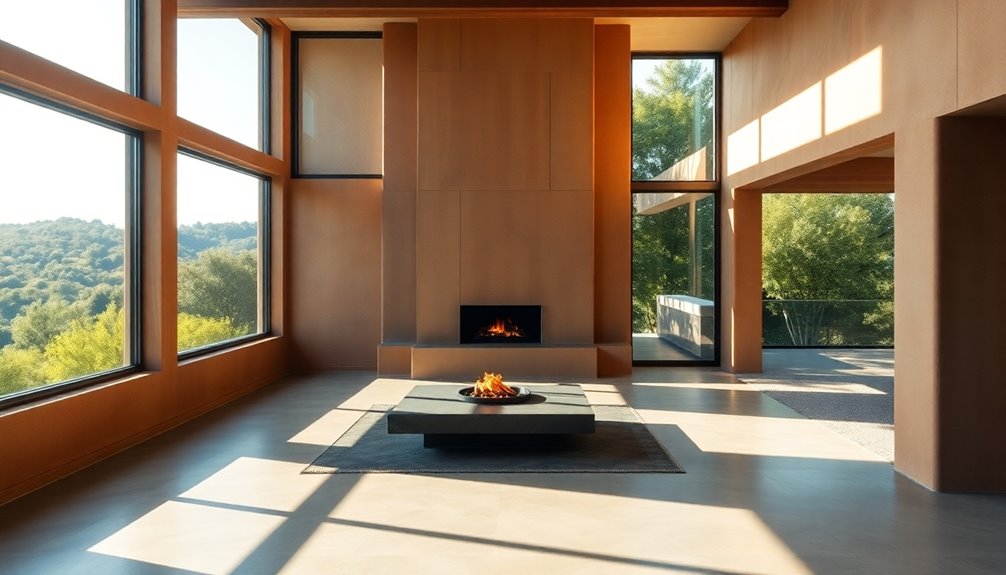Thermal mass is essential for enhancing your home’s energy efficiency. It involves materials like concrete and stone that absorb, store, and release heat, helping you maintain stable indoor temperatures. This reduces your heating and cooling needs, potentially lowering energy costs by up to 30%. By smartly integrating thermal mass with insulation and HVAC systems, you can create a comfortable living environment. Discover how to maximize the benefits of thermal mass in your home design.
Key Takeaways
- Thermal mass materials, such as concrete and stone, absorb and store heat, moderating indoor temperatures and enhancing energy efficiency.
- Properly integrated thermal mass can reduce heating and cooling costs by up to 30% through efficient temperature regulation.
- Effective thermal mass design stabilizes indoor climates, especially in areas with significant day-night temperature fluctuations.
- Combining thermal mass with insulation minimizes heat loss, further improving energy efficiency and indoor comfort.
- AI integration in HVAC systems optimizes energy use by predicting heating and cooling needs based on thermal mass characteristics.
What Is Thermal Mass?

Thermal mass plays an essential role in home energy efficiency by acting as a thermal reservoir. It refers to the ability of certain materials, like concrete and brick, to absorb, store, and release heat energy effectively.
High thermal mass materials possess considerable volumetric heat capacity, enhancing their ability to moderate indoor temperatures. In climates with notable day-night temperature variations, these materials can absorb heat during the day and release it at night, promoting a comfortable indoor temperature.
Properly integrating thermal mass with insulation is key; without adequate insulation, you risk rapid heat loss, which can negate its benefits. Additionally, incorporating energy-efficient designs can further optimize the performance of thermal mass by minimizing electricity consumption.
Types of Thermal Mass Materials

When choosing thermal mass materials for your home, consider how each option impacts heat retention and aesthetics.
Concrete excels in storing heat effectively, while natural stone adds visual appeal alongside its thermal benefits.
On the other hand, wood offers lower thermal mass properties, making it less effective for heat storage compared to denser materials. Additionally, it is important to ensure that any wood stove installed in conjunction with thermal mass materials complies with local fire safety regulations to maintain a safe environment.
Concrete’s Heat Retention
Many homeowners find concrete to be an excellent choice for heat retention in their homes. With a volumetric heat capacity of about 2060 kJ/m³·K, concrete acts as an effective thermal mass, storing significant amounts of thermal energy.
Thicker concrete slabs enhance this capability, stabilizing indoor temperatures throughout the day and night. When combined with passive solar design, concrete floors can absorb sunlight during the day, slowly releasing it at night, which helps reduce reliance on HVAC systems.
Its high density moderates temperature fluctuations, maintaining comfort in homes with varying climates. By incorporating concrete as a thermal mass material, homeowners can boost energy efficiency and potentially lower energy costs by up to 30%. Additionally, the use of geothermal heat pumps in conjunction with thermal mass can further enhance energy efficiency by utilizing the Earth’s stable temperature for climate control.
Natural Stone Aesthetics
Natural stone offers a unique blend of beauty and functionality, making it a favored choice for homeowners seeking to enhance their living spaces.
With its high thermal mass properties, natural stone effectively absorbs and retains solar heat, helping to stabilize indoor temperatures. This not only improves energy efficiency but also elevates comfort levels in your home.
The aesthetic appeal of materials like granite, limestone, and sandstone creates visually stunning environments that enhance any design. Additionally, integrating natural materials into your home design can further promote sustainability and a connection with the environment.
Plus, using locally sourced natural stone supports sustainable building practices, ensuring longevity and reducing the need for replacements.
Wood’s Thermal Properties
Wood’s unique characteristics make it an intriguing option in the domain of thermal mass materials. While it has a lower density and specific heat capacity than high thermal mass materials like concrete, it still plays a role in thermal performance. Wood effectively minimizes heat transfer through insulation, contributing to energy-efficient design. When combined with higher thermal mass materials, it balances overall energy use. Incorporating wood into home design can complement modern farmhouse decor trends that emphasize natural materials and sustainability.
| Property | Wood |
|---|---|
| Volumetric Heat Capacity | 1,500 – 3,000 kJ/m³·K |
| Aesthetic Appeal | Natural warmth and beauty |
| Temperature Fluctuations | Moderates effectively |
Incorporating wood strategically can enhance comfort while maintaining aesthetic appeal, making it a valuable choice in building design.
How Thermal Mass Affects Energy Efficiency

Thermal mass materials like concrete and brick can play an essential role in your home’s energy efficiency.
By storing heat during the day and releasing it at night, they can greatly cut down your heating and cooling needs.
When you integrate thermal mass with smart design strategies, you not only enhance comfort but also boost your home’s overall energy performance. Additionally, using wood as a renewable resource can further improve energy efficiency by reducing reliance on traditional heating systems.
Thermal Mass Materials Overview
While many factors influence a home’s energy efficiency, the choice of thermal mass materials plays an essential role in regulating indoor temperatures.
Materials like concrete, brick, and stone have high heat capacities, allowing them to absorb and release heat effectively. Concrete, for instance, boasts a heat capacity of about 2060 kJ/m³·K, while brick and stone follow closely with 1360 kJ/m³·K and 1800 kJ/m³·K, respectively.
This ability is especially beneficial in climates with considerable temperature fluctuations, where thermal mass can store heat during the day and release it at night. Additionally, incorporating energy-efficient models can further enhance overall home energy savings by working in tandem with thermal mass to optimize heating and cooling.
Benefits of Thermal Mass
Energy efficiency is greatly enhanced by the strategic use of thermal mass in home design. By incorporating materials like concrete and brick, you can considerably reduce energy consumption, as they absorb heat during the day and release it at night.
This stabilizes indoor temperatures and lowers your heating and cooling needs by up to 30%. In climates with notable temperature fluctuations, thermal mass helps maintain consistent indoor conditions, enhancing comfort.
When integrated with proper insulation, it minimizes thermal bridging and heat loss, further supporting energy efficiency. Plus, utilizing thermal mass contributes to your home’s durability against pests and water damage, ensuring long-term resilience. Additionally, maintaining indoor air quality through air purifiers can complement the benefits of thermal mass by reducing airborne pollutants and allergens.
Ultimately, embracing thermal mass can lead to a more comfortable, energy-efficient living environment.
Integrating With Design Strategies
Incorporating thermal mass into your home design isn’t just about choosing the right materials; it’s also about how you strategically integrate them.
By using building materials like concrete and brick, you can enhance energy efficiency through their high volumetric heat capacity. Proper insulation and air tightness are essential, as they help maintain comfortable indoor temperatures while reducing reliance on heating and cooling systems.
In climates with considerable day-night temperature variations, thermal mass can provide effective temperature stabilization. Implementing design strategies such as large thermal mass surfaces and shading devices prevents overheating and optimizes energy consumption throughout the year. Additionally, incorporating energy-efficient appliances can complement your thermal mass strategy by minimizing overall energy use.
Ultimately, a thoughtful integration of thermal mass in your design can greatly enhance the overall comfort and efficiency of your home.
Optimizing HVAC Systems With Thermal Mass

To optimize HVAC systems effectively, leveraging thermal mass can be a game-changer for your home’s energy efficiency.
By using materials like concrete and brick, thermal mass absorbs heat during the day and releases it at night, reducing the load on heating and cooling systems.
Integrating thermal mass data into building management systems enables dynamic adjustments based on real-time occupancy and weather conditions, enhancing occupant comfort.
You could see energy costs drop by up to 30% as this approach minimizes the need for active heating and cooling during peak times.
Implementing strategies like night purging and preconditioning further capitalizes on natural temperature fluctuations, allowing your HVAC systems to operate more efficiently while maintaining a comfortable indoor environment.
Additionally, combining thermal mass with energy-efficient systems can lead to even greater savings and reduced environmental impact.
Benefits of Integrating AI With Thermal Mass

While traditional methods of managing HVAC systems have their merits, integrating AI with thermal mass offers transformative benefits that enhance energy efficiency and comfort.
By utilizing predictive analytics, AI maximizes your HVAC operations based on the unique thermal mass characteristics of your home. This leads to energy savings of up to 30% by predicting heating and cooling needs more accurately.
AI monitors indoor temperatures and occupancy, dynamically adjusting settings to maintain ideal comfort levels while minimizing energy use. It also improves air quality by managing ventilation systems effectively.
Furthermore, AI can implement night purging strategies, leveraging thermal mass for natural cooling during off-peak hours, reducing reliance on mechanical systems and ensuring your home remains comfortable and efficient year-round.
Strategies for Utilizing Thermal Mass in Home Design

When you design a home with thermal mass, you can considerably enhance energy efficiency and comfort.
Here are some strategies to evaluate:
Explore strategies to enhance your home’s thermal mass for improved energy efficiency and comfort.
- Choose High Thermal Mass Materials: Use concrete, brick, or stone for effective heat absorption during the day and nighttime release.
- Maximize Surface Area: Incorporate larger, darker surfaces that can absorb more heat, improving thermal performance.
- Optimize Orientation and Windows: Position windows and design your home to capture sunlight, ensuring maximum heat absorption.
- Integrate Shading Mechanisms: Use overhangs or vegetation to prevent overheating while maintaining the benefits of thermal mass.
Frequently Asked Questions
Where Should You Put Thermal Mass?
You should place thermal mass in areas with direct sunlight, like south-facing walls and floors, to capture heat during the day.
Position it near large windows or glass doors to absorb solar heat and release it slowly at night.
Incorporating materials like concrete or stone in high-traffic areas, such as living rooms or entryways, helps regulate indoor temperatures.
Also, consider shading strategies in summer to prevent overheating and enhance comfort.
How Much Thermal Mass Do I Need?
You need to contemplate your climate when deciding how much thermal mass to incorporate. For every square meter of glazing, aim for 30-50 kg of thermal mass.
If you live in an area with significant temperature swings, a higher amount will help. Typically, including thermal mass that accounts for 15-30% of your total wall area will optimize temperature regulation.
Remember to place it where it’ll get plenty of sunlight for maximum effectiveness.
How Can Thermal Mass Help in the Design of a Home?
Thermal mass can greatly enhance your home design by stabilizing indoor temperatures.
By incorporating materials like concrete or brick, you’ll absorb heat during the day and release it at night, creating a comfortable environment. This approach reduces the need for heating and cooling, saving you money on energy bills.
Strategically placing these materials in areas that receive sunlight can maximize their effectiveness, making your home more energy-efficient and comfortable year-round.
How Does Mass Affect Thermal Energy?
You might think that mass doesn’t impact thermal energy much, but it actually plays a vital role.
When you use high-density materials, like concrete, they absorb and store heat better than lighter ones. This means they can release that heat when temperatures drop, keeping your space comfortable.
The more mass you have, the more effectively it can regulate temperature fluctuations, making it a smart choice for energy efficiency in any design.
Conclusion
Incorporating thermal mass into your home design can greatly enhance energy efficiency and comfort. By choosing the right materials and optimizing your HVAC systems, you can create a more sustainable living space. Plus, with the integration of AI, managing thermal mass becomes even smarter. Isn’t it time you considered how these elements could transform your home? Embracing thermal mass not only benefits your energy bills but also contributes to a healthier environment for everyone.









